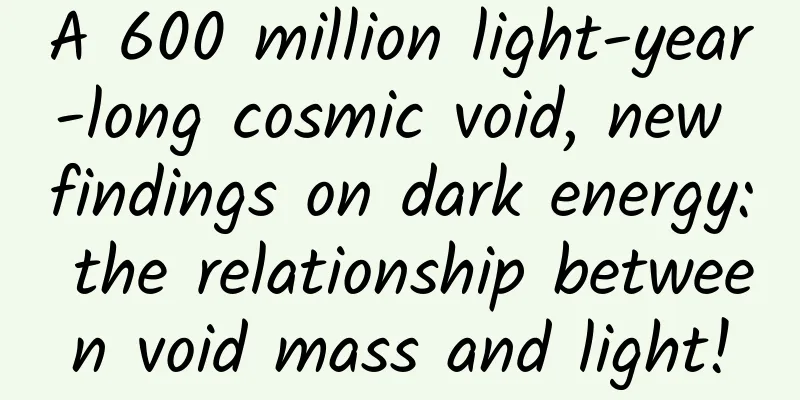A 600 million light-year-long cosmic void, new findings on dark energy: the relationship between void mass and light!

|
The Dark Energy Survey (DES) uses patterns in macroscopic cosmic structure seen in the spatial distribution of billions of galaxies to reveal the nature of "dark energy," the most likely cause of the accelerating expansion of the universe. Since it began in 2013, the Dark Energy Survey has mapped more than 10% of the sky using a 570-million-pixel digital camera and five filters that provide galaxy colors to estimate redshift distances. Astronomers at the Harvard Smithsonian Center for Astrophysics are part of a team of more than 400 scientists in seven countries studying dark energy, and last year it released its first set of data. "Cosmic voids occupy a large portion of the volume of the Universe, and unlike galaxy clusters and other compact structures that are strongly influenced by gravitational effects, not to mention processes associated with galaxy formation, these voids are the lowest-density regions in the Universe with relatively simple dynamics, which makes them particularly simple to constrain cosmological parameters. Astronomers at the Harvard Smithsonian Center for Astrophysics analyzed the first data release with the goal of describing the relationship between mass and light around cosmic voids. The scientists used statistical models to analyze the two-dimensional and three-dimensional distribution of galaxies." The latter is obtained by calculating the distances to galaxies from the redshifts measured by photometry. The two methods are found to agree well with each other and with models in which the physics of void environments is very simple and the amount of emitted light is proportional to its mass. Voids with diameters between about 100 million and 600 million light years are well-suited to enable mass-to-light tests to better than 10%. With future, more advanced observations, the improved statistics should enable useful new consistency tests of gravity, general relativity, and dark matter scenarios. What are the masses and galaxy profiles of cosmic voids? In the new study, researchers used two methods to extract voids in the Dark Energy Survey (DES) one-year redshift galaxy sample to address this question. Voids were identified using either a 2D distribution, or a 3D distribution of galaxies based on photometric redshift. For the mass profile, the study measured the tangential shear profile of background galaxies to infer the excess surface mass density. For both void samples, the measured signal-to-noise ratio was between 10.7 and 14.0. Their 3D density distribution was inferred by model fitting based on N-body simulations, and good agreement was found for void radii in the range of 15-85 MPC. By comparing with galaxy profiles, the relationship between mass and light can be tested at the 10% level, which is the most stringent test to date. We also found that the shapes of the two profiles are very similar, and the linear relationship between mass and light is consistent both inside and outside the void radius. We validated our analysis with the help of simulated star catalogs and estimated the impact of the photometric redshift uncertainty on the measurement. The methodology can be used for cosmological applications, including gravitational tests with voids. This is particularly promising when gravitational lensing profiles are combined with spectroscopic measurements of the void dynamics through redshift space distortions. Bokeyuan|www.bokeyuan.net Boco Park | Research/From: Harvard Smithsonian Center for Astrophysics Reference journal Monthly Notices of the Royal Astronomical Society DOI: 10.1093/mnras/stz2805 BoKeYuan|Science, technology, research, popular science |
<<: The History of Vaccines: Technologies, Diseases, and Challenges
Recommend
These diseases are all related to obesity! If your weight exceeds this number, you are in danger!
How many obese people are there in China? After 1...
There are really no new features to add, so Android 12 has to add a "Recycle Bin" feature
The mobile phone operating system has developed t...
After school starts, two diseases are prevalent, parents must pay attention →
After the spring semester begins, hand, foot and ...
Foshan tutoring WeChat mini program function, how much does it cost to develop a tutoring appointment mini program?
With the increasingly fierce competition, more and...
Over 100 days! Wang Yaping sets a new record again!
Launched on October 16, 2021 Shenzhou 13 It will ...
Useful information丨7 technical laws that marketers must know. How can you survive in the marketing circle without knowing these!
Not every marketer needs to be tech-savvy. Howeve...
Surprise! Forehead wrinkles are related to cardiovascular disease?
Have you ever looked in the mirror and suddenly f...
Short video ads are very popular, the key is how to get users to pay for them!
Since mid-2016, short video feeds and Native Ads ...
2017 Big Data Festival is coming in October, iResearch A10 Summit will open on the 27th
As a major event in the field of big data in Chin...
China's first Olympic gold medal 40 years ago! The ten rings in the shooting competition turned out to be so small? !
Review expert: Peng Guoqiu, deputy chief physicia...
Learn the correct approach to cold-starting content-based products from Douban!
Douban's cold start was quite successful. Of ...
The 200th anniversary of the critical phenomenon. Who first discovered this physical phenomenon?
Commemorates the bicentenary of the discovery of ...
Router backdoor vulnerabilities have endless hidden dangers and it is urgent to strengthen security protection
Last weekend, the "2013 China Internet Networ...
Gentleman is not white_Taobao Internet celebrity store 100% store opening method
Hello everyone, I am Shen Bai. Friends and studen...
How to develop the Tik Tok mini program? How to develop the Tik Tok mini program?
As a hot spot for traffic, the "Tik Tok plat...









